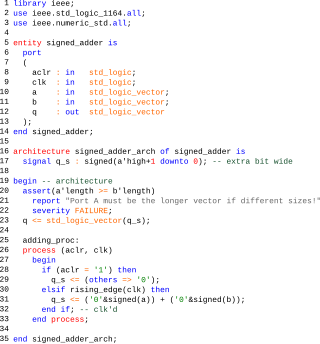Logic programming is a programming, database and knowledge representation paradigm based on formal logic. A logic program is a set of sentences in logical form, representing knowledge about some problem domain. Computation is performed by applying logical reasoning to that knowledge, to solve problems in the domain. Major logic programming language families include Prolog, Answer Set Programming (ASP) and Datalog. In all of these languages, rules are written in the form of clauses:
The relational model (RM) is an approach to managing data using a structure and language consistent with first-order predicate logic, first described in 1969 by English computer scientist Edgar F. Codd, where all data is represented in terms of tuples, grouped into relations. A database organized in terms of the relational model is a relational database.

VHDL is a hardware description language that can model the behavior and structure of digital systems at multiple levels of abstraction, ranging from the system level down to that of logic gates, for design entry, documentation, and verification purposes. The language was developed for the US military VHSIC program in the 1980s, and has been standardized by the Institute of Electrical and Electronics Engineers (IEEE) as IEEE Std 1076; the latest version of which is IEEE Std 1076-2019. To model analog and mixed-signal systems, an IEEE-standardized HDL based on VHDL called VHDL-AMS has been developed.

Saul Aaron Kripke was an American analytic philosopher and logician. He was Distinguished Professor of Philosophy at the Graduate Center of the City University of New York and emeritus professor at Princeton University. Kripke is considered one of the most important philosophers of the latter half of the 20th century. Since the 1960s, he has been a central figure in a number of fields related to mathematical and modal logic, philosophy of language and mathematics, metaphysics, epistemology, and recursion theory.

Exclusive or, exclusive disjunction, exclusive alternation, logical non-equivalence, or logical inequality is a logical operator whose negation is the logical biconditional. With two inputs, XOR is true if and only if the inputs differ. With multiple inputs, XOR is true if and only if the number of true inputs is odd.

Isaac Watts was an English Congregational minister, hymn writer, theologian, and logician. He was a prolific and popular hymn writer and is credited with some 750 hymns. His works include "When I Survey the Wondrous Cross", "Joy to the World", and "Our God, Our Help in Ages Past". He is recognised as the "Godfather of English Hymnody"; many of his hymns remain in use today and have been translated into numerous languages.
Edward Jonathan Lowe, usually cited as E. J. Lowe but known personally as Jonathan Lowe, was a British philosopher and academic. He was Professor of Philosophy at Durham University.
In digital circuit design, register-transfer level (RTL) is a design abstraction which models a synchronous digital circuit in terms of the flow of digital signals (data) between hardware registers, and the logical operations performed on those signals.

Dignāga was an Indian Buddhist scholar and one of the Buddhist founders of Indian logic. Dignāga's work laid the groundwork for the development of deductive logic in India and created the first system of Buddhist logic and epistemology (pramāṇa).
In computer science, a Van Wijngaarden grammar is a formalism for defining formal languages. The name derives from the formalism invented by Adriaan van Wijngaarden for the purpose of defining the ALGOL 68 programming language. The resulting specification remains its most notable application.
In mathematical logic, a propositional variable is an input variable of a truth function. Propositional variables are the basic building-blocks of propositional formulas, used in propositional logic and higher-order logics.
SystemVerilog, standardized as IEEE 1800, is a hardware description and hardware verification language used to model, design, simulate, test and implement electronic systems. SystemVerilog is based on Verilog and some extensions, and since 2008, Verilog is now part of the same IEEE standard. It is commonly used in the semiconductor and electronic design industry as an evolution of Verilog.
The event calculus is a logical theory for representing and reasoning about events and about the way in which they change the state of some real or artificial world. It deals both with action events, which are performed by agents, and with external events, which are outside the control of any agent.
Formal epistemology uses formal methods from decision theory, logic, probability theory and computability theory to model and reason about issues of epistemological interest. Work in this area spans several academic fields, including philosophy, computer science, economics, and statistics. The focus of formal epistemology has tended to differ somewhat from that of traditional epistemology, with topics like uncertainty, induction, and belief revision garnering more attention than the analysis of knowledge, skepticism, and issues with justification.
In logic, the comprehension of an object is the totality of intensions, that is, attributes, characters, marks, properties, or qualities, that the object possesses, or else the totality of intensions that are pertinent to the context of a given discussion. This is the correct technical term for the whole collection of intensions of an object, but it is common in less technical usage to see 'intension' used for both the composite and the primitive ideas. A logic gate is a device that acts as a building block for digital circuits. They perform basic logical functions that are fundamental to digital circuits. Most electronic devices we use today will have some form of logic gates in them.
In mathematical logic, Lindenbaum's lemma, named after Adolf Lindenbaum, states that any consistent theory of predicate logic can be extended to a complete consistent theory. The lemma is a special case of the ultrafilter lemma for Boolean algebras, applied to the Lindenbaum algebra of a theory.
Héctor-Neri Castañeda was a Guatemalan-American philosopher and founder of the journal Noûs.
Tux3 is an open-source versioning filesystem created by Daniel Phillips. He introduced the filesystem as a public replacement for his Tux2 filesystem which had encountered licensing issues due to the filing of several patents. Phillips had previously created the Htree directory indexing system which eventually became an official feature of ext3. The technical details of Tux3 were first publicized in an email on 23 July 2008.
Circuit underutilization also chip underutilization, programmable circuit underutilization, gate underutilization, logic block underutilization refers to a physical incomplete utility of semiconductor grade silicon on a standardized mass-produced circuit programmable chip, such as a gate array type ASIC, an FPGA, or a CPLD.
In network theory, link prediction is the problem of predicting the existence of a link between two entities in a network. Examples of link prediction include predicting friendship links among users in a social network, predicting co-authorship links in a citation network, and predicting interactions between genes and proteins in a biological network. Link prediction can also have a temporal aspect, where, given a snapshot of the set of links at time , the goal is to predict the links at time . Link prediction is widely applicable. In e-commerce, link prediction is often a subtask for recommending items to users. In the curation of citation databases, it can be used for record deduplication. In bioinformatics, it has been used to predict protein-protein interactions (PPI). It is also used to identify hidden groups of terrorists and criminals in security related applications.





